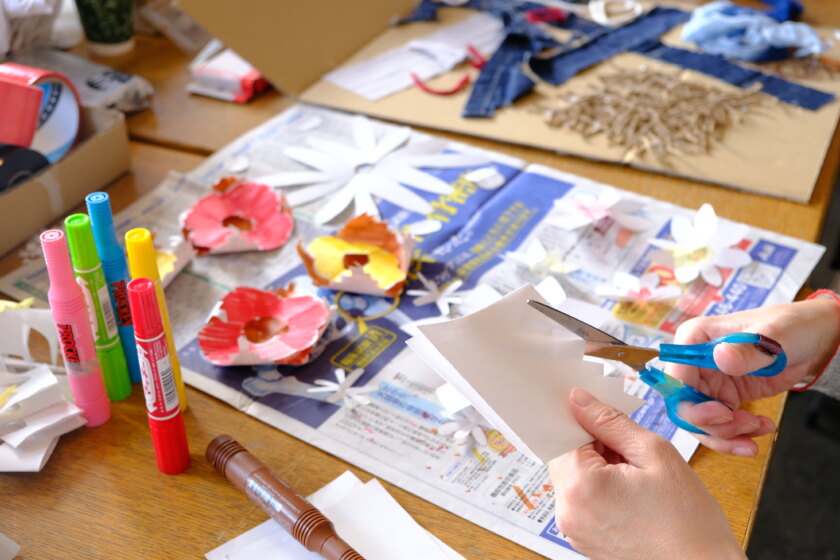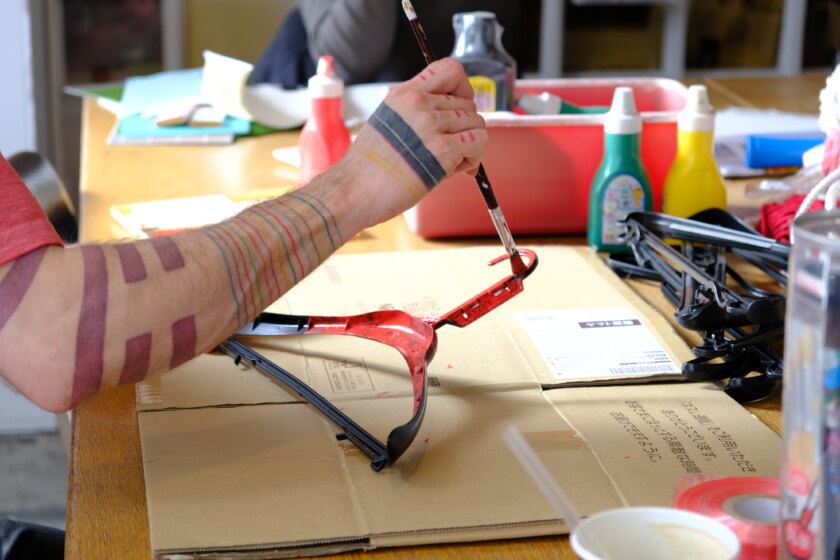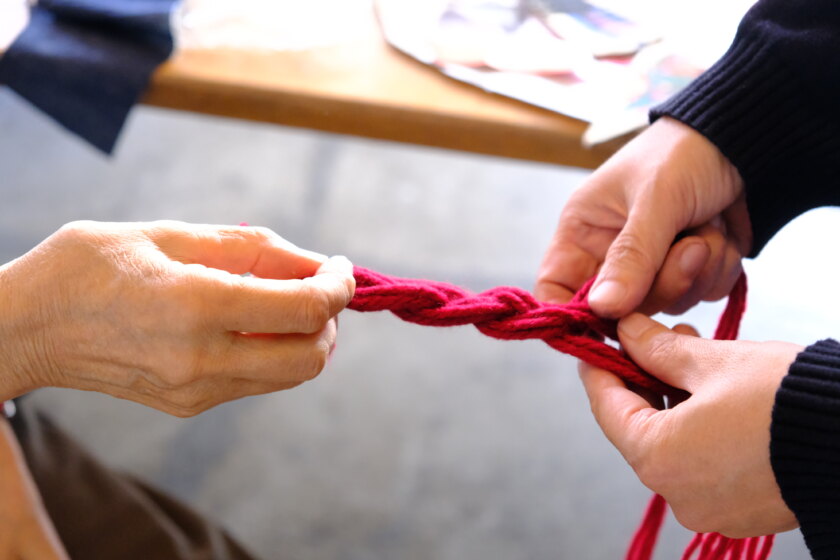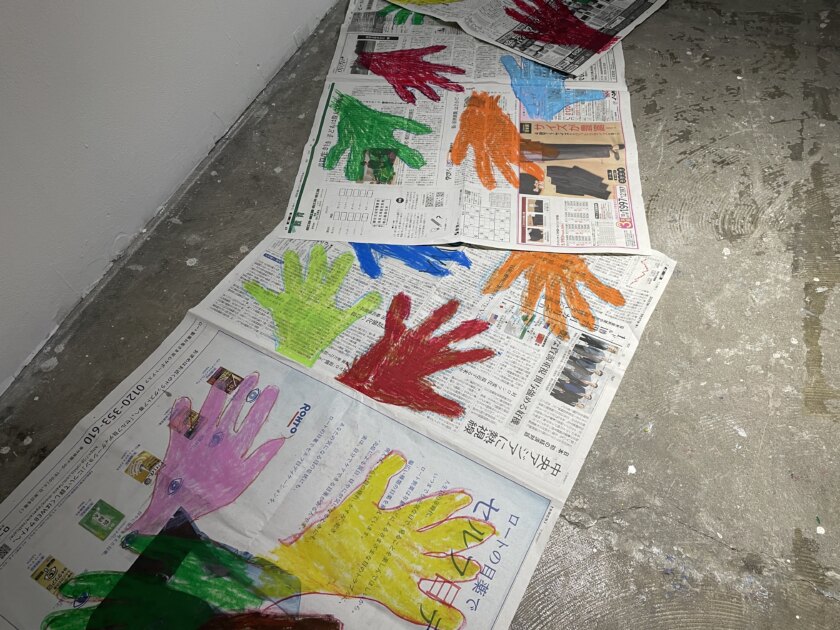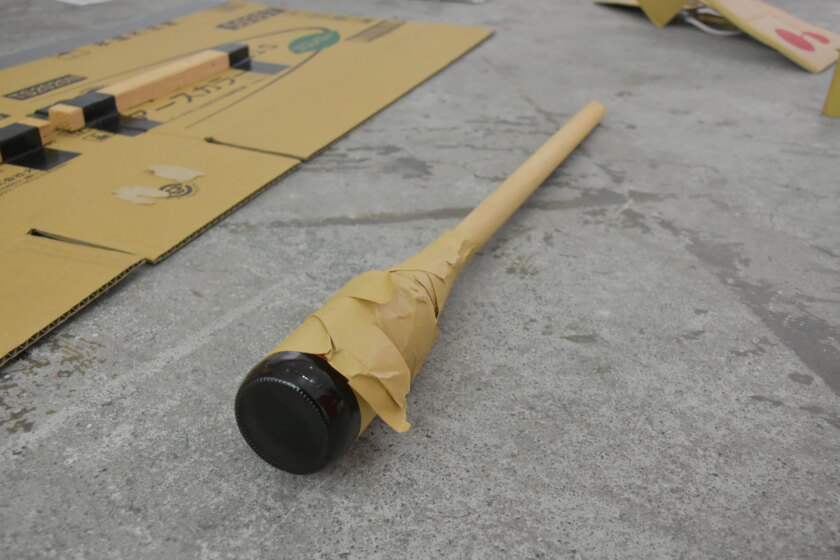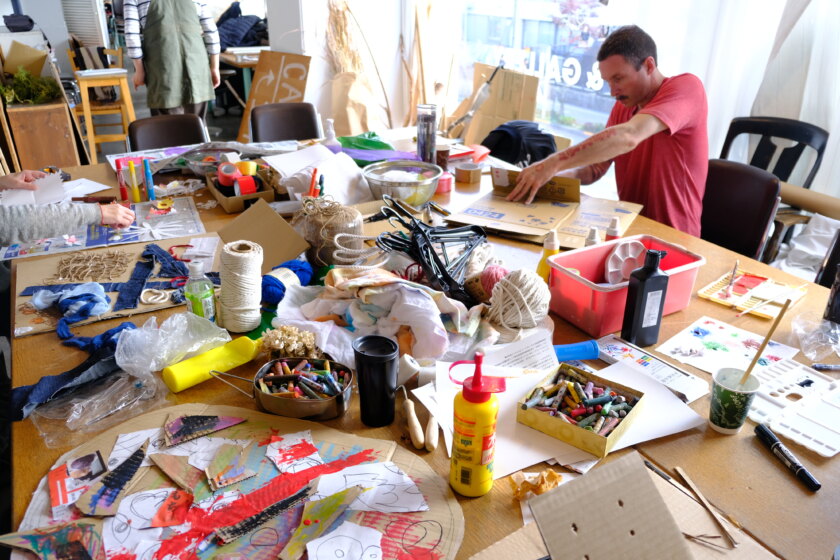<Act/Abstract>
Inspired by public demonstrations and similar civic activities and their performative and cultural character, participants during this workshop will be asked to design (collectively and individually) abstract banners and other accessories typical for manifestations. The main goal of this project is to decontextualize and study ideas of support and protest, especially in reference to the concept of crowd/mass, its language and aesthetics as well as its socio-political angle and anthropological significance.
<Act/Abstract>
デモンストレーションや市民活動、それらが持つパフォーマティブで文化的な特徴から着想を得て、「抽象的」なバナーやプラカード、ステッカーなどを個人/グループでデザインしてみます。このプロジェクトの主な目的は、支持と抗議の概念を文脈から解きほぐし、特に群衆/大衆の概念、その言語と美学的なものだけではなく、社会政治的な視点と人類学的な意義も含め、考察することです。
制作手順:
①自分が日々の中で「主張」したいものごとについて考える。そしてそれが抗議の気持ちなのか、支持の気持ちなのか、考える。
②好きな材料を使い、その主張をなるべく抽象化し、表してみる。
ピョトル・ブヤクのステートメントより
================
◉ 作業中の参加者とピヨの会話
*ピョトル=Pio
*当日ピョトルは英語で参加者へ語り、必要に応じて通訳が行われました。その場のやりとりのリズム感や雰囲気を重視した内容になっています。会話の中の翻訳部分は《 》で示されています。
Pio|In a protest you usually manifest or stand against some particular issue, however in a demonstration, you could also show support. And I feel that when it comes to a more abstract designing process, you have to have somewhat more emotional clarity whether you resist or support something.
《抗議は主張やある特定のものごとに対する抵抗のために、デモは何かへの支持を表すことができる。自分が主張したい気持ちは、抗議なのか、支持なのかということは、今日やる抽象的なデザインを行うにあたって大切な部分なのではと思う。》
Pio | Normally, when you go to demonstrations, there are lots of casual words and regular signs with dedicated phrases, but it actually can get quite limiting. Sometimes it is convenient – in the cognitive process – to figure out a strategy to express one’s statement (or stand) without using the actual language. That also allows us to re-evaluate a given problem from a different angle.
《普段、デモに行くとたくさんの、時には最小限まで削られたカジュアルな言葉やわかりやすいサインが並んでいる。自身の主張を言葉なしで表現する方法を編み出すことは、認知の過程で役に立ったりする。与えられた課題を別の角度から見直すことにもつながるんだ。》
◉ 作業中の参加者とピヨの会話
手を動かしながら交わされた、ピヨと参加者の会話の抜粋です。
参加者|抽象っていうのは、モノに例えられないくらい抽象的に?
《Do you have to make it abstract so that it cannot be compared to something? 》
Pio | As abstract as you can go.
《できる限り抽象化してほしい。》
ーーーーー
Pio|Hangers are interesting. In Poland, three years ago, the ruling party had extremely limited access to legal abortion. The bill regulating that case was very strict. Shortly after this law became effective, there were mass demonstrations all over Poland to show support with oppressed women and this particularly inhuman policy. One of the main prop/item used by demonstration participants were hangers. Back in the days in Central Europe hangers – especially those made of wire – were used as one of the most popular and DIY tools to terminate the pregnancy by oneself. In 2019 people who went to the streets used such hangers as a symbol.
《ハンガーは興味深いね。3年前、ポーランドでは与党が合法的な中絶へのアクセスを極めて制限してしまった。とても厳しい法律でね。この法が有効になった直後、ポーランド中で抑圧された女性たちへの支援と、非人間的な政策に反対する大規模なデモが行われた。そのデモの中でよく用いられたアイテムがハンガーだった。ハンガー、特にワイヤーでできたものは、中央ヨーロッパでは、昔、手っ取り早く、DIY的に女性たちが自分で堕胎するためによく用いられた道具だった。だから2019年は、人はハンガーを手に通りに出た。》
参加者|中絶を禁止するというのは、宗教的な影響もあるんですか?
《Is there a religious influence behind the ban on abortion?》
Pio|Yes, it has been significantly affected by religious propaganda. But in my opinion it is mainly the conservative, right-wing state agenda to hold even more control over people. Fortunately after elections in Poland three weeks ago, the tendency of the current, newly elected government is quite directly opposite, making it reasonable to hopefully go out with the hangers in a way altered, like colouring it pink or rainbow etc., to show support to a possible more “liberal” turn in that matter.
《そうだね。宗教的なプロパガンダの影響はあると思う。でも主に保守的で右翼の国家政策で国が人々をさらにコントロールしたかったからだと思うよ。3週間前にまたポーランドで選挙があって、幸いにも新しく選ばれた政権の傾向はかなり逆。ハンガーはアレンジされ、ピンクや虹色に塗られたものを持って通りに出るようになった。今の政権への可能性や期待も持ちつつね。》
Pio | Sometimes, a very basic gesture is enough. It can create a necessary context, even if it is as simple as just colouring the object. It can become less critical in a direct sense and emotionally negative/aggressive, but more like expressing a hope that things can change. In my research, I am really interested in this kind of gestures, recontextualising one’s presence in a public space and eventually the idea of “resisting/resistance” itself.
《すごくシンプルな働きかけで十分だったりするよね。例えばただ色を塗るだけで、必要な文脈や背景をものに与えることができる。それは時に直接的な批判、感情的な否定や攻撃を含むものではなくなり、何かが変わるということへの希望を表すことも可能になる。私は自身のリサーチにおいて、このようなシンプルなジェスチャーによってもたらされる、公共の場における個の文脈の再構築や、そこから考えられる抵抗/抵抗する行為そのものにとても興味がある。》
Pio | The context and the meaning of a protest gives a possibility to change the reading of an item into something completely different. The thing is, a seemingly neutral object doesn’t have to be neutral. The idea of its reappropriation by a public demonstration and protest can totally change that.
《文脈や、抗議の持つ意味合いが、あるものの文脈をまったく別の何かに変える可能性があるんだ。一見ニュートラルな、ただのものに見えるが、そうである必要はない。公のデモや抗議運動によって再定義が起こり、ものの文脈が変わることがあるということだ。》
参加者|このハンガーにリボンをつけたらいいかも。
《 Maybe it will be nice if you try to put some ribbon on this hanger.》
Pio|If that’s expressing your thoughts, go ahead.
《それが自分の考えを表すことにつながるなら、お好きにどうぞ。》
ーーーーー
Pio | We call it `tulips`. Because, it looks like a tulip when it’s cracked. It’s kind of a deadly weapon.You use it for serious street fights.
《私たちはこれをチューリップと呼ぶ。割れた時の形がチューリップみたいだからね。これは怖い武器だよね。街中でやる本気の闘争とかで使う。》
参加者|安保闘争の時、石とか棒を投げたりはしてたのはテレビで見てたけど、こんな(チューリップみたいな)瓶はあんまり見た記憶が無いね。
《During the Anpo tōsō, I saw people throwing rocks and sticks on TV, but I don’t remember seeing many bottles like this (tulip).》
Pio | Maybe you used bottles when you made Molotov cocktails—which is like a very simple grenade.
《モロトフ・カクテル(火炎瓶)を作った時に瓶を使ったりしたんじゃない?すごくシンプルな手榴弾みたいなものだよ。》
ーーーーー
参加者|最近はデモをするにも警察の許可とかが必要ですよね。
《Nowadays, you need permissions from the police to demonstrate.》
Pio|Yes. We also asked for permission when we had a demonstration in front of the Polish embassy in Japan, about the law prohibiting abortion.
《そうだね。中絶禁止法のデモを日本のポーランド大使館の前でやった時も一応許可をとったよ。》
参加者|ポーランドでも許可は必要なんですか?
《Do you need permission in Poland too?》
Pio|Theoretically we do. I mean it’s kind of like a grey area. Sometimes the city needs to protect the people attending the demonstration. But often protests and demos just happen naturally, in a very grass-root, unorchestrated way. Obviously one might get arrested if the event would have been considered to have gone too far, but this risk is also a crucial part of the whole thing.
《理論上はね。グレーゾーンな感じ。街がデモの参加者を守らないといけない場合もあるし。でも勝手にデモや抗議が発生することもしょっちゅうあるよ。無計画で草の根的な感じで。もちろん、やり過ぎると捕まる可能性もあるけど、そのリスクも重要な要素の一つだよね。》
ーーーーー
参加者|作ったものを持って、散歩とかしたら面白そう。
《It might be nice if we could have a walk holding these props that we have just created.》
Pio | That will be the best! We can change it to the performative action. Let’s walk around Koganei.
《それは最高だね!作るという行為をパフォーマティブなアクションに変換する。小金井をぶらぶらしよう。》
参加者|文字書いてないからなんだかよくわからないね。デモをする許可はいらない。
《No one will know what this is all about, since it doesn’t have words on it. So we don’t need permission to do the demonstration.》
Pio | No one will know if it’s Matsuri (Japanese festival) or demonstration or whatever. It is interesting.When you think about it, Matsuri is very similar to the idea of demonstration. It’s just that Matsuri is usually rather affirmative. But they are also based on a crowd marching from point A to point B, just like a demonstration.
《ぱっと見、これが祭りなのか、デモなのか、なんなのか、誰もわからないよね。面白いね。考えてみると、祭りもデモと構造がけっこう似ているような気がする。肯定的なものか、そうじゃないか、はあるけどね。祭りも大衆がポイントAからポイントBまで行進する。デモと同じだね。》
ーーーーー
参加者|タトゥーの意味が知りたいです。
《 What’s the meaning of your red tattoo?》
Pio|It doesn’t have a meaning, but it has inspiration. You know that I come from a very punk, anarchist background. Not even as an artist, but as a citizen, or as an individual. I care a lot about minorities, people excluded and so on. This one is largely inspired by the immune disease. In Central Europe, HIV virus, AIDS are still rendered as a huge stigma. When you get infected with AIDS, skin changes colour in a random manner. And usually it becomes red or violet. And to some degree, this is kind of an aestheticized AIDS variation.
《意味はないけど、インスピレーションはあるよ。私はとてもパンクでアナーキストな背景から来てることは知ってるでしょ。アーティストとしてだけでなく、一市民として、また個人として。私は少数派や排除された人々がとても気になっている。これは免疫疾患から大いにインスパイアされたものなんだ。中欧では、HIVウイルスやAIDSはまだ巨大なスティグマとされている。AIDSに感染すると、肌の色が無作為に変わる。通常、赤や紫になることが多い。これは美的に表現されたAIDSの一種とも呼べる。》
ーーーーー
Pio|How was it today?
《今日はどうだった?》
参加者|中々自由にはいかなかったですね。考えすぎちゃうことも。
《It was quite difficult. I overthink sometimes.》
Pio | Sometimes, you just need to work αt your own pace. Pretty often I used to get quite paralyzed by thinking.
《自分のペースで作業することもたまには必要だよね。私もしょっちゅう考えることにとらわれていた。》
参加者1|ピヨの作るスピードがすごかった。引き出しがないとアウトプットできないですよね。インプットして、初めてアウトプットが生まれる。
《The speed of Pio producing things was amazing. If you are not knowledgeable, you can’t produce output. You can only output if you have inputs.》
参加者2|普段考えていることはそれこそ出るかな、と。みんなそれぞれ、日常でいろんなことを考えながら暮らしてるからね。
《We all think about various things in our daily lives. So things that we think in our daily lives will be the output I think.》
Pio | Look at this work. You have just pierced the cardboard. That’s sometimes really enough. Usually people try their best to produce a single element and it can consume a lot of time. And that is not a completely wrong approach, as I don’t really believe in such an idea as a “completely wrong approach”, but since I am producing a lot of things next to you, you may get inspired by my actions. By doing this work together, you might get affected and apply my strategy to your own way of making artworks. If you compare the ones that you made at the beginning and the ones that you made towards the end it is clear. And it becomes also clear by looking at my works, that I got influenced by you pretty much as well.
《この作品を見て。あなたは段ボールに穴を開けただけだね。でも、それで本当に十分な時もある。一つのものを、時間をかけて、一生懸命作る人が多い。それは間違ったアプローチではないし、「間違ったアプローチ」なんてものがあるとは私も思っていないけど、私がみんなの横で次から次へポンポンものをつくることによって、その動作が自然にみんなに伝染していくのかなと思う。このワークを共に行うことで、私の制作スタイルが自身のスタイルの中に少し浸透していく感じかな。はじめた頃と最後の方で、全然皆の作り方が変化したように感じた。逆に、私の作ったものを見てわかるように、私も皆の影響を受けた。》
================
◉ゲストプロフィール
ピョトル・ブヤク|Piotr Bujak
1982年生まれ。東京とクラクフ在住。映像、インスタレーション、立体、テキストなど多様な技法を用いて制作を行う。アクティビストでもある。ヤン・マテイコ美術アカデミー(クラクフ、ポーランド)とサンフランシスコ・アート・インスティチュート卒業。対抗的パンク文化、ミニマリズム、コンセプチュアリズム、ネオ・アヴァンギャルド、批評的言説に関心をもつ。「低予算、素早く雑に、DIYで、打って走る(Low Budget, Quick and Dirty, Do It Yourself and Hit and Run)」を戦略としつつ、新自由主義の病理、暴力、同一性、文化や政治領域と関連する作品を制作している。
https://culture.pl/en/artist/piotr-bujak

